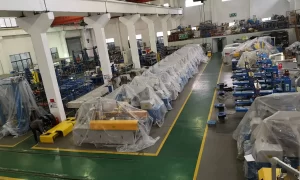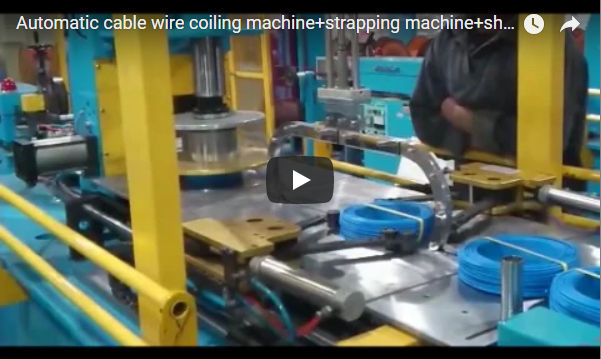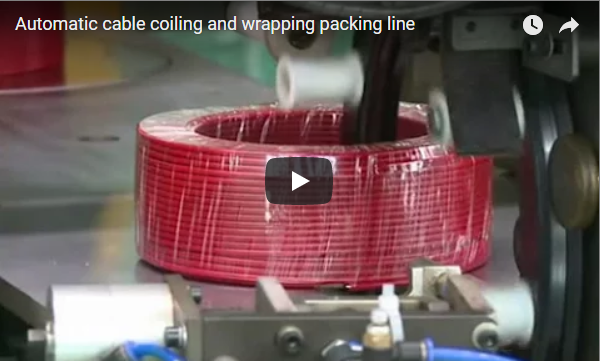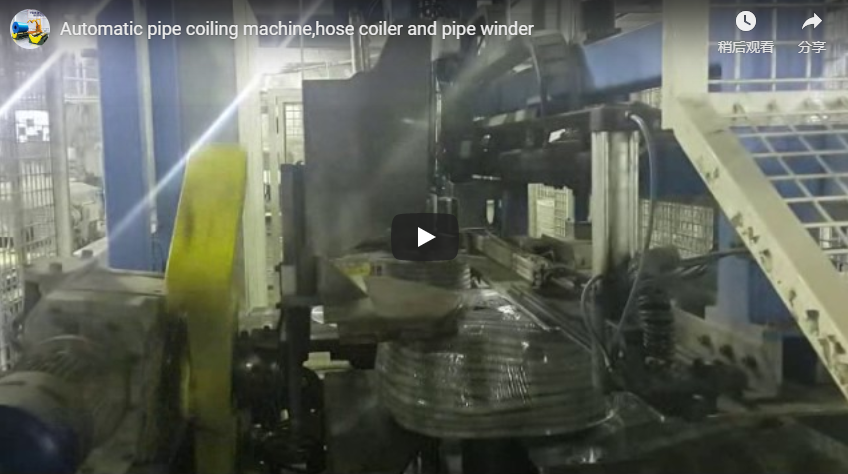Streamlining Cable Packaging: An In-Depth Look at Automated Coiling, Wrapping, and Robotic Palletizing Systems
The demands on modern cable manufacturers require increasingly efficient and reliable end-of-line packaging solutions. Manual processes for coiling, wrapping, and palletizing cables are often labor-intensive, prone to inconsistencies, and present potential ergonomic risks. Addressing these challenges, fully automated cable packaging lines, like the system showcased above, integrate multiple processes into a seamless workflow, delivering significant improvements in throughput, quality, and operational cost-effectiveness. This article delves into the technical specifications, operational advantages, and design considerations of such advanced systems.

1. System Overview: From Extruder to Pallet
This integrated packaging line is engineered to handle cable directly from production (online integration with extruders or pay-off stands) or as a standalone unit (offline operation). Its core function is to automatically coil specified lengths of cable, secure the coil with stretch wrap, and then utilize robotics to stack the finished coils onto pallets according to pre-programmed patterns.
2. Core Process Breakdown and Technical Capabilities
The system comprises several key modules working in concert:
2.1. Precision Cable Coiling Unit:
- Function: Accurately measures and coils cable to specified lengths and dimensions.
- Key Components: Servo-driven coiling head, precision length counter (encoder-based), adjustable traversing unit for neat layer winding, pneumatic cutters.
- Technical Data (Typical Ranges):
- Cable Diameter Range: 3mm - 15mm (Varies by model)
- Coil Inner Diameter (ID): 150mm - 400mm (Adjustable)
- Coil Outer Diameter (OD): 300mm - 600mm (Adjustable)
- Coil Width/Height: 50mm - 200mm (Adjustable)
- Coiling Speed: Up to 150 m/min (Dependent on cable type and coil size)
- Length Accuracy: ± 0.5%
2.2. Automated Stretch Wrapping Station:
- Function: Applies stretch film tightly around the finished coil to maintain its shape, protect it from dust and moisture, and prepare it for handling.
- Key Components: Rotary wrapping ring or turntable, powered film pre-stretch carriage (often achieving 200-300% stretch), automatic film clamp and cut system.
- Technical Data (Typical Ranges):
- Wrapping Material: LLDPE Stretch Film
- Film Width: 100mm - 250mm
- Cycle Time: 20-40 seconds per coil (Dependent on wraps required)
2.3. Robotic Palletizing Cell:
- Function: Picks wrapped coils from the wrapping station or conveyor and precisely places them onto a pallet in a defined stacking pattern.
- Key Components: 6-axis industrial robot arm (e.g., Fanuc, ABB, Kuka, Yaskawa), custom-designed end-of-arm tooling (EOAT) / gripper for secure coil handling, pallet dispenser (optional), slip sheet applicator (optional), safety fencing and sensors (light curtains, area scanners).
- Technical Data (Typical Ranges):
- Robot Payload: 20kg - 100kg+ (Matching coil weight)
- Reach: Sufficient to cover pallet dimensions and infeed/outfeed positions.
- Stacking Patterns: User-programmable via HMI
- Pallet Sizes Handled: Standard sizes (e.g., 1200x1000mm, 1200x800mm), custom sizes possible.
- Maximum Stack Height: Typically up to 2000mm.
3. Technical Data Comparison: Automated vs. Manual
| Feature | Automated System | Manual Process |
|---|---|---|
| Throughput | High (e.g., 2-5 coils/min) | Low (Variable, operator dependent) |
| Consistency | Very High (Length, Coil Shape, Wrap, Stack) | Low to Moderate |
| Labor Required | Minimal (Supervision, Loading) | High (Multiple Operators) |
| Length Accuracy | High (± 0.5% typical) | Moderate (± 1-2% or more) |
| Wrap Quality | Consistent, Optimal Stretch | Variable, Potential Waste |
| Stack Stability | High (Programmed Patterns) | Moderate, Operator Skill Dep. |
| Ergonomics | Eliminates Manual Handling | High Risk (Lifting, Bending) |
| Footprint | Defined System Area | Can be Dispersed, Less Dense |
| Initial Cost | High | Low |
| Operating Cost | Lower (Labor, Material Opt.) | Higher (Labor, Potential Waste) |
4. Design, Structure, and Components
- Modular Design: Allows for flexibility in layout and potential future upgrades or modifications. Modules can often be configured for different line flows.
- Robust Construction: Utilizes heavy-duty steel frames designed for continuous operation in industrial environments.
- Integrated Control System: Typically managed by a central PLC (Programmable Logic Controller) with a user-friendly HMI (Human-Machine Interface) touchscreen. The HMI allows for recipe management (storing parameters for different cable types and coil sizes), diagnostics, and operational control.
- High-Quality Components: Employs reliable industrial components such as servo motors and drives for precise motion control, VFDs (Variable Frequency Drives) for speed regulation, pneumatic systems for actuation, and robust sensors (photoelectric, proximity, laser) for detection and positioning.
- Safety Integration: Incorporates comprehensive safety features compliant with international standards (e.g., ISO 13849), including safety interlocks, E-stops, light curtains, and protective guarding.
5. Operational Advantages and User Experience
Implementing such an automated line offers tangible benefits:
- Increased Efficiency: Continuous operation significantly boosts output compared to manual methods.
- Cost Reduction: Lowers labor costs, reduces material waste (optimized film usage), and minimizes product damage during handling.
- Improved Product Quality: Ensures consistent coil dimensions, wrap tightness, and stable pallet stacks, enhancing customer satisfaction.
- Enhanced Workplace Safety: Removes strenuous and repetitive manual tasks, reducing the risk of musculoskeletal injuries.
- Data Logging & Connectivity: Modern systems often feature capabilities for data logging (production counts, cycle times, fault logs) and can be integrated into plant-wide monitoring systems (MES, SCADA) via protocols like Ethernet/IP or Profinet, aligning with Industry 4.0 principles. Learn more about the benefits of automation in manufacturing from Authoritative sources like the Association for Advancing Automation (A3).
From a user perspective, the HMI simplifies operation. Operators can typically select pre-programmed recipes, monitor the system status, and receive alerts for maintenance or faults. Training requirements are focused on system oversight and basic troubleshooting rather than intensive manual labor skills.
6. Integration Flexibility: Online vs. Offline
- Online Integration: The system receives cable directly from an extrusion line or primary coiling/spooling machine. This requires synchronization signals between the production line and the packaging system to manage start/stop and speed variations, ensuring a continuous flow.
- Offline Integration: The system operates independently. Coils are brought to the machine manually or via AGVs/conveyors. This provides flexibility but may require intermediate storage or handling steps.

7. Target Industries and Applications
This type of automated packaging line is ideal for medium to high-volume manufacturers in sectors including:
- Building Wire and Cable
- Telecommunications Cable (Copper and Fiber Optic)
- Automotive Wiring
- Appliance Wiring
- Power Cable (Low Voltage)
Conclusion
Automated cable coiling, wrapping, and palletizing lines represent a significant technological advancement for the wire and cable industry. By integrating these processes with robotic handling, manufacturers can achieve substantial improvements in efficiency, consistency, safety, and cost-effectiveness. The technical sophistication, exemplified by precise servo control, optimized material usage, and advanced robotics, provides a robust solution for meeting modern production demands and maintaining a competitive edge.
For further information or specific inquiries regarding system configuration and capabilities:
Website: www.fhopepack.com
Email: coiler@fhopepack.com





